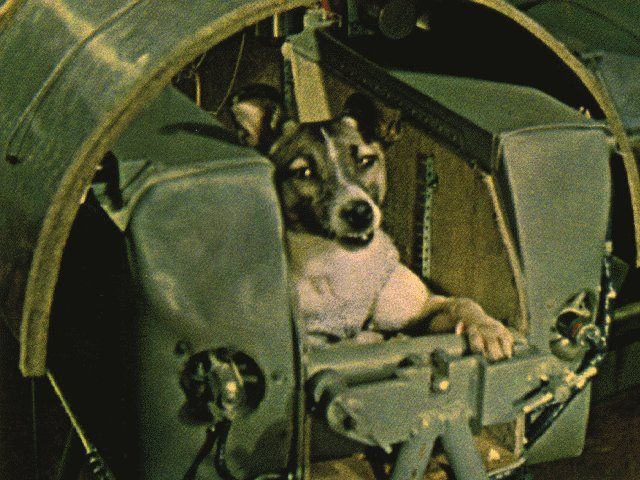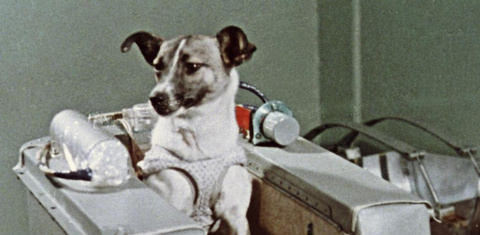Sixty-eight years ago, on November 3, 1957, a small dog with bright eyes and a calm spirit left Earth and entered the quiet expanse of space. Her name was Laika—a gentle stray from the streets of Moscow whose journey became one of the most meaningful chapters in human exploration.
Although she never returned home, her story continues to move generations. Laika’s mission was one of courage, science, and the complex choices that accompany progress. Today, her memory inspires reflection, compassion, and a renewed respect for the animals whose lives intersect with human ambition.

A Soft Beginning: From the Streets to the Stars
Laika was chosen not for pedigree or strength, but for her gentle nature. Those who met her often described her kind expression and calm presence. As a stray, she had learned to adapt to cold winds, busy streets, and unpredictable days. These qualities—resilience, patience, and quiet bravery—made her the unexpected candidate for a place in history.
Soviet scientists, preparing for a pioneering mission, sought an animal who could remain steady in unfamiliar environments. Laika stood out. She was tender, trusting, and remarkably composed.
One scientist even brought her home the night before the mission. He let her play freely, spent time with her, and allowed her to rest in a warm, peaceful space. It was a moment of kindness that echoes through time—a reminder that even in great scientific efforts, human hearts remain present.

Rising Into Orbit: A Journey Meant for Discovery
On November 3, 1957, Laika boarded Sputnik 2. It was an extraordinary moment for the world. No living being had ever traveled into orbit before. The capsule lifted from the Earth, rising through layers of light, air, and silence.
Laika could not understand the significance of her journey, but humanity did. Her mission aimed to answer one crucial question:
Could a living creature endure the passage from Earth to space?
At the time, technology was limited. Sputnik 2 was designed only for travel outward, not for a safe return. It was a one-way voyage intended to gather information that would eventually make human spaceflight possible.
For many years, the world believed Laika stayed in orbit comfortably for several days. Later reports, shared long after the mission, suggested that the capsule experienced difficulties early in the flight. Due to rising temperatures and stress inside the spacecraft, her mission ended much sooner than anyone had hoped. While details have been discussed by historians and scientists, they are often described gently out of respect for her legacy.

Her Legacy: A Gentle Life That Changed the Future
Laika’s mission demonstrated something extraordinary:
A living body could endure the powerful ascent from Earth into orbit.
This discovery became a foundation for the achievements that followed—including the first human spaceflight. Her journey helped researchers understand how to support life beyond Earth, leading to better spacecraft design, improved safety measures, and deeper knowledge about human physiology in space.
Her contribution was meaningful far beyond her small size. She helped open a path to the stars.
Across the world, Laika became a symbol—of exploration, of courage, and of the ethical questions that come with scientific advancement. Her story encouraged both admiration for her bravery and reflection on the responsibilities humans carry when working with animals.

A Poetic Echo: Why Laika Still Lives in Our Hearts
Laika’s memory has grown into something timeless. Statues and memorials stand in her honor. Books and songs recall her gentle face. She appears in classrooms, documentaries, art, and quiet conversations between people who wonder how progress should be balanced with compassion.
More than six decades later, her presence still feels near.
People often describe her as “the little dog who touched the sky.” Others see her as a reminder to ask deeper, more thoughtful questions before saying yes to any great ambition.
Her story encourages us to be careful, to be kind, and to consider the cost of every discovery.
What Laika Teaches Us Today
1. Progress Must Be Paired With Compassion
Laika’s mission changed science, but it also sparked global reflection. Many people today see her story as a reminder that innovation and ethics must evolve together.
2. Animals Deserve Respect and Care
Her journey inspired new guidelines and greater awareness around the treatment of animals in research. Over the decades, standards have risen significantly, shaped partly by the emotion her story stirred worldwide.
3. Kindness Leaves a Lasting Light
The quiet act of a scientist who let her sleep in his home before the mission remains one of the most touching moments in her narrative. It shows that even small gestures of love can echo through history.
A Soft Goodbye That Still Resonates
Laika may not have returned to Earth, but she has never been forgotten. The world continues to honor her not just as a scientific figure, but as a gentle soul who carried humanity’s hopes higher than anyone had imagined possible.
She was a good dog.
She deserved comfort, care, and a safe return.
And although she could not come home, her memory has remained—bright, enduring, and cherished.
Sixty-eight years have passed, yet her story still invites us to reflect, to feel, and to ask better questions about the choices we make in the name of progress.
Thank you, Laika.
We remember you.
We will always remember you.
